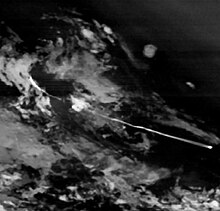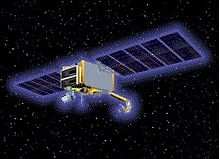Space-Based Infrared System
The Space-Based Infrared System ( SBIRS , English for space-based infrared system ) is an American system of missiles - early warning military satellites that is being set up and which will succeed the Defense Support Program (DSP).
history
The DSP has been the space component of missile advance warning and defense for around 30 years. The United States Department of Defense (DoD) has tried several times since the 1980s to develop a successor system for the DSP:
- the Advanced Warning System ( AWS ) in the early 1980s
- the Boost Surveillance and Tracking System ( BSTS ) in the late 1980s
- the Follow-on Early Warning System ( FEWS ) in the early 1990s
According to the Government Accountability Office (GAO), these attempts failed due to immature technology, high costs and budget availability.
Based on experiences during the Second Gulf War (1991), the Ministry of Defense decided that an expansion of the capabilities for early warning of tactical short-range missiles was needed. In 1994, because of these needs, SBIRS was selected as a system that would provide advance warning of both these and long-range strategic weapons.
SBIRS uses more advanced infrared technologies than DSP to improve the ability to detect strategic and tactical missile launches and the accuracy of trajectory tracking. For example, the detectors are three times as sensitive as those in the DSP series.
Since the beginning of its development, the SBIRS program has been struggling with steadily rising costs, which led to the Nunn-McCurdy Amendment being exceeded several times in 2003, 2005, 2006 and 2007. The total cost of the system is currently estimated at $ 10 billion. In 2006, as a countermeasure against the massive cost overruns, the Ministry of Defense decided to develop a concept for a technologically simpler and more cost-effective alternative, the Alternative Infrared Satellite System ( AIRSS ).
SBIRS high
The SBIRS-High component of the system enables missile launches to be observed from great heights. Functionally, it corresponds to the previous DSP system, but with significantly increased accuracy and sensitivity. SBIRS-High consists of two different sub-components:
- the SBIRS-GEO satellite in geostationary orbit
- the SBIRS-HEO payloads, which are located as additional payloads on board other military satellites in a highly elliptical orbit .
The current planning includes six GEO satellites and four HEO payloads.
SBIRS-GEO
SBIRS-GEO consists of stand-alone satellites in geostationary orbit. These satellites have a cubic satellite body with two solar cell arms and are three-axis stabilized . Each SBIRS-GEO satellite carries two SBIRS sensors. In contrast to the DSP satellites, the SBIRS-GEO satellites have an apogee motor for launching into geostationary orbit. The mass of the satellites is not published, but it can be deduced from the performance data of the planned launch rockets that the launch mass is between 4210 kg and 4950 kg.
The main contractor for the sensors is Lockheed Martin in collaboration with Northrop Grumman (formerly TRW ) as the largest subcontractor. Lockheed Martin is also responsible for the satellite structures, which are based on the commercial A2100 model.
GEO-1 was put into orbit in May 2011, the launch of GEO-2 took place on March 19, 2013. The procurement of GEO-3 was initially unsecured and was dependent on experience with the SBIRS sensors that were launched first. In 2007 the US Air Force decided to acquire a third GEO satellite with the option of a fourth satellite. In January 2011, the US Air Force approved the construction of the fourth satellite. Orders for the fifth and sixth satellites were placed in March 2013.
| satellite | date | Starting place | Launcher | Remarks |
|---|---|---|---|---|
| SBIRS-GEO-1 | May 7, 2011 | CCAFS SLC-41 | Atlas V (401) | success |
| SBIRS-GEO-2 | March 19, 2013 | CCAFS SLC-41 | Atlas V (401) | success |
| SBIRS-GEO-3 | January 21, 2017 | CCAFS SLC-41 | Atlas V (401) | success |
| SBIRS-GEO-4 | 19th January 2018 | CCAFS SLC-41 | Atlas V (411) | success |
| SBIRS-GEO-5 | 2021 | CCAFS SLC-41 | Atlas V (421) | planned |
| SBIRS-GEO-6 | 2022 | CCAFS SLC-41 | Atlas V (421) | planned |
SBIRS-HEO
In contrast to GEO, SBIRS-HEO consists of a sensor package that is mounted as an additional payload on a military satellite that is in a highly elliptical orbit. These satellites are either communications satellites of the Satellite Data System or ELINT reconnaissance satellites .
As with GEO, the main contractor for the sensors is Lockheed Martin in cooperation with Northrop Grumman (formerly TRW ) as the largest subcontractor.
The HEO-1 and HEO-2 payloads have both been completed and handed over to the US Air Force. HEO-1 was launched into space on board the secret NRO-L-22 satellite in mid-2006 and has been delivering good results ever since. The parent satellite for HEO-2 is NRO-L-28, which was indirectly confirmed by a notice of the successful testing of the second SBIRS HEO payload. Based on the positive experience with the first payload, two more HEO payloads were approved in 2007.
| satellite | date | Starting place | Launcher | comment |
|---|---|---|---|---|
| SBIRS-HEO-1 (on board NROL-22) | June 28, 2006 | VAFB SLC-6 | Delta IVM + (4.2) | success |
| SBIRS-HEO-2 (on board NROL-28) | March 13, 2008 | VAFB SLC-3E | Atlas-V (411) | success |
| SBIRS-HEO-3 (on board NROL-35) | December 13, 2014 | VAFB SLC-3E | Atlas V (541) | success |
| SBIRS-HEO-4 (on board NROL 42) | September 24, 2017 | VAFB SLC-3E | Atlas V (541) | success |
SBIRS-Low
SBIRS-Low was a component that was supposed to supplement the SBIRS system with 24 observation satellites in polar, low orbits in order to ensure a denser spatial coverage in the polar regions.
After several restructurings, the SBIRS-Low program is now being continued by the Missile Defense Agency under the name Space Tracking and Surveillance System (STSS) . The STSS-ATRR (Space Tracking and Surveillance System - Advanced Technology Risk Reduction) is what was previously called the STSS Block 2010 Risk Reduction Satellite and is intended to test alternative technologies . The satellite (also known as USA 205) was launched on May 5, 2009 with a Delta-II rocket from Vandenberg. Two other satellites originally built for the SBIRS-LEO program, STSS Demo 1 and STSS Demo 2, were launched on September 25, 2009.
Web links
- SBIRS at Air Force Space Command
- SBIRS at Lockheed Martin (English)
- Theater Ballistic Missile Warning , US Strategic Command (English, archived November 2013)
- Space-Based Infrared System Low at Risk of Missing Initial Deployment Date , US General Accounting Office, February 2001
- Space Tracking and Surveillance System (STSS) (PDF file; 0.2 MB; April 2004)
- United Launch Alliance: Space Tracking and Surveillance System Demonstration - Mission Overview (PDF file; 2.2 MB; English)
Individual evidence
- ↑ Budget Busters: The USA's SBIRS-High Missile Warning Satellites . defenseindustrydaily.com, February 21, 2019
- ↑ CDI: Fact Sheet on Space Based Infrared System ( Memento of November 13, 2007 in the Internet Archive )
- ↑ Space News Business Report: SBIRS Alternative Will Keep Missile Warning on Track (English)
- ↑ a b SBIRS continues reaching successful milestones (English)
- ↑ Lockheed gets GEO-4 infrared satellite go-ahead: Option exercised for contractor to build fourth geosynchronous satellite for the Space-Based Infared Systems program.
- ↑ Lockheed Martin: US Air Force Awards Lockheed Martin Contract for Next Set of Infrared Surveillance Satellites , March 5, 2013
- ↑ Space.com: US Military Launches New Missile Warning Satellite Into Space
- ^ Atlas V to Launch SBIRS GEO Flight 4 for the US Air Force. United Launch Alliance, January 19, 2018, archived from the original on January 23, 2018 ; accessed on January 22, 2018 (English).
- ↑ a b Stephen Clark: SpaceX, ULA win military contracts, Air Force renames EELV program . Spaceflight Now, March 7, 2019.
- ↑ US Air Force / Lockheed Martin Team Completes On-Orbit Checkout Of First SBIRS HEO Payload . Lockheed Martin press release dated November 17, 2006.
- ↑ Second SBIRS payload completes early on-orbit checkout . US Air Force press release dated June 23, 2008.
- ↑ a b Gunter Krebs: 'Trumpet-F / O' 1, 2. In: Gunter's Space Page. June 2, 2017, accessed July 13, 2017 .
- ↑ a b Gunter Krebs: 'Trumpet-F / O-2' 1, 2. In: Gunter's Space Page. September 24, 2017, accessed September 25, 2017 .




